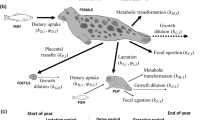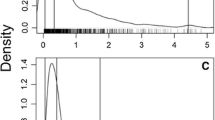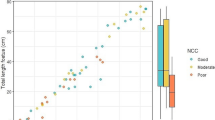Abstract
Polychlorinated biphenyls (PCBs) can cause endocrine disruption, cancer, immunosuppression, or reproductive failure in animals. We used an individual-based model to explore whether and how PCB-associated reproductive failure could affect the dynamics of a hypothetical polar bear (Ursus maritimus) population exposed to PCBs to the same degree as the East Greenland subpopulation. Dose–response data from experimental studies on a surrogate species, the mink (Mustela vision), were used in the absence of similar data for polar bears. Two alternative types of reproductive failure in relation to maternal sum-PCB concentrations were considered: increased abortion rate and increased cub mortality. We found that the quantitative impact of PCB-induced reproductive failure on population growth rate depended largely on the actual type of reproductive failure involved. Critical potencies of the dose–response relationship for decreasing the population growth rate were established for both modeled types of reproductive failure. Comparing the model predictions of the age-dependent trend of sum-PCBs concentrations in females with actual field measurements from East Greenland indicated that it was unlikely that PCB exposure caused a high incidence of abortions in the subpopulation. However, on the basis of this analysis, it could not be excluded that PCB exposure contributes to higher cub mortality. Our results highlight the necessity for further research on the possible influence of PCBs on polar bear reproduction regarding their physiological pathway. This includes determining the exact cause of reproductive failure, i.e., in utero exposure versus lactational exposure of offspring; the timing of offspring death; and establishing the most relevant reference metrics for the dose–response relationship.


Similar content being viewed by others
References
Basu N, Scheuhammer AM, Bursian SJ, Elliott J, Rouvinen-Watt K, Chan HM (2007) Mink as a sentinel species in environmental health. Environ Res 103:130–144
Bernhoft A, Wiig Ø, Skaare JU (1997) Organochlorines in polar bears (Ursus maritimus) at Svalbard. Environ Pollut 95:159–175
Bernhoft A, Skaare JU, Wiig O, Derocher AE, Larsen HJ (2000) Possible immunotoxic effects of organochlorines in polar bears (Ursus maritimus) at Svalbard. J Toxicol Environ Health A 59(7):561–564
Braathen M, Derocher AE, Wiig Ø, Sørmo EG, Lie E, Skaare JU et al (2004) Relationships between PCBs and thyroid hormones and retinol in female and male polar bears. Environ Health Perspect 112(8):826–833
Brunstrom B, Lund B, Bergman A, Asplund L, Athanassiadis I, Athanasiadou M et al (2001) Reproductive toxicity in mink (Mustela vison) chronically exposed to environmentally relevant polychlorinated biphenyl concentrations. Environ Toxicol Chem 20(10):2318–2327
Bursian SJ, Sharma C, Aulereich RJ et al (2006) Dietary exposure of mink (Mustela vison) to fish from the Housatonic river, Berkshire County, Massachusetts, USA: effects on reproduction, kit growth, and survival. Environ Toxicol Chem 25(6):1533–1540
Bytingsvik J, Lie E, Aars J et al (2012) PCBs and OH-PCBs in polar bear mother-cub pairs: a comparative plasma levels in 1998 and 2008. Sci Total Environ 417:117–128
de Wit CA, Muir DCG (2010) An overview of temporal trends of legacy and emerging contaminants in the Arctic and possible implications for top predators and humans. Organohal Compd 72:1392–1395
Derocher AE, Wiig O (2002) Postnatal growth in body length and mass of polar bears (Ursus maritimus) at Svalbard. J Zool 256:343–349
Derocher AE, Wolkers H, Colborn T, Schlabach M, Larsen TS, Wiig Ø (2003) Contaminants in Svalbard polar bear samples archived since 1967 and possible population level effects. Sci Total Environ 301:163–174
Dietz R, Rigét FF, Sonne C, Born EW, Bechshøft T, McKinney MA et al (2013) Part 1: three decades (1984–2010) of legacy contaminant trends in East Greenland polar bears (Ursus maritimus). Environ Int 59:485–493
Dietz R, Gustavson K, Sonne C et al (2015) Physiologically-based pharmacokinetic modelling of immune, reproductive and carcinogenic effects from contaminant exposure in polar bears (Ursus maritimus) across the Arctic. Environ Res 140:45–55
Fuchsman PC, Barber TR, Bock MJ (2008) Effectiveness of various exposure metrics in defining dose–response relationships for mink (Mustela vison) exposed to polychlorinated biphenyls. Arch Environ Contam Toxicol 54:130–144
Gebbink WA, Sonne C, Dietz R, Kirkegaard M, Born EW, Muir DCG et al (2008) Target tissue selectivity and burdens of diverse classes of brominated and chlorinated contaminants in polar bears (Ursus maritimus) from East Greenland. Environ Sci Technol 42:752–759
Grimm V, Martin BT (2013) Mechanistic effect modeling for ecological risk assessment: where to go from here? Integr Environ Assess Manag 9(3):e58–e63
Grimm V, Revilla E, Berger U et al (2005) Pattern-oriented modeling of agent-based complex systems: lessons from ecology. Science 310:987–991
Grimm V, Berger U, Bastiansen F, Eliassen S, Ginot V, Giske J et al (2006) A standard protocol for describing individual-based and agent-based models. Ecol Model 198:115–126
Grimm V, Berger U, DeAngelis DL, Polhill JG, Giske J, Railsback SF (2010) The ODD protocol: a review and first update. Ecol Model 221:2760–2768
Gutleb AC, Cenijn P, Velzen MV, Lie E, Ropstad E et al (2010) In vitro assay shows that PCB metabolites completely saturate thyroid hormone transport capacity in blood of wild polar bears (Ursus maritimus). Environ Sci Technol 44(8):3149–3154
Hall AJ, McConnell BJ, Rowles TK, Aguilar A, Borrell A, Schwacke L et al (2006a) Population consequences of polychlorinated biphenyl exposure in bottlenose dolphins: an individual based model approach. Environ Health Perspect 114(Suppl 1):60–64
Hall AJ, Hugunin K, Deaville R et al (2006b) The risk of infection from polychlorinated biphenyl exposure in the harbor porpoise (Phocoenaphocoena): a case-control approach. Environ Health Perspect 114:704–711
Hazlerigg CRE (2011) Fish population ecology and ecological risk assessment. PhD thesis, Imperial College, London, p 170
Heaton SN, Bursian SJ, Giesy JP, Tillitt DE, Render JA, Jones PD et al (1995) Dietary exposure of mink to carp from Saginaw Bay, Michigan. I. Effects on reproduction and survival and the potential risks to wild mink populations. Arch Environ Contam Toxicol 28:334–343
Henriksen EO, Wiig Ø, Skaare JU, Gabrielsen GW, Derocher AE (2001) Monitoring PCBs in polar bears: lessons learned from Svalbard. J Environ Monit 3:493–498
Jenssen BM, Villanger GD, Gabrielsen KM, Bytingsvik J, Bechshoft T, Cisielski TM et al (2015) Anthropogenic flank attack on polar bears: interacting consequences of climate warming and pollution exposure. Front Ecol Environ 3(16):1–7
Kannan K, Blankenship AL, Jones PD, Giesy JP (2000) Toxicity reference values for the toxic effects of polychlorinated biphenyls to aquatic mammals. Hum Ecol Risk Assess 6(1):181–201
Kleiber M (1975) The fire of life: an introduction to animal energetics, 2nd edn. Robert E Kreiger Publishing, Huntington
Knott KK, Boyd D, Ylitalo GM, Todd M, O’Hara TM (2012) Lactational transfer of mercury and polychlorinated biphenyls in polar bears. Chemosphere 88(4):395–402
Larsen T (1986) Population biology of the polar bear (Ursus maritimus) in the Svalbard area. Norsk Polarinstitutt, Oslo
Letcher RJ, Gebbink WA, Sonne C, Born EW, McKinney MA, Dietz R (2009) Bioaccumulation and biotransformation of brominated and chlorinated contaminants and their metabolites in ringed seals (Pusa hispida) and polar bears (Ursus maritimus) from Eastern Greenland. Environ Int 35:1118–1124
Letcher RJ, Bustnes JO, Dietz R et al (2010) Exposure and effects assessment of persistent organohalogen contaminants in arctic wildlife and fish. Sci Total Environ 408(15):2995–3043
Lie E, Larsen HJ, Larsen S, Johansen GM, Derocher AE, Lunn NJ et al (2004) Does high organochlorine (OC) exposure impair the resistance to infection in polar bears (Ursus maritimus)? Part I: effect of OCs on the humoral immunity. J Toxicol Environ Health A 67(7):555–582
Lie E, Larsen HJ, Larsen S, Johansen GM, Derocher AE, Lunn NJ et al (2005) Does high organochlorine (OC) exposure impair the resistance to infection in polar bears (Ursus maritimus)? Part II: possible effect of OCs on mitogen- and antigen-induced lymphocyte proliferation. J Toxicol Environ Health A 68(6):457–484
Martin BT, Jager T, Nisbet RM, Preuss TG, Grimm V (2014) Limitations of extrapolating toxic effects on reproduction to the population level. Ecol Appl 24(8):1972–1983
McKinney MA, Letcher RJ, Aars J, Born EW, Branigan M, Dietz R et al (2011) Flame retardants and legacy contaminants in polar bears from Alaska, Canada, East Greenland and Svalbard 2005–2008. Environ Int 37:365–374
Noonburg EG, Nisbet RM, Klanjscek T (2010) Effects of life history variation on vertical transfer of toxicants in marine mammals. J Theor Biol 264:479–489
Oskam IC, Ropstad E, Dahl E, Lie E, Derocher AE, Wiig O et al (2003) Organochlorines affect the major androgenic hormone, testosterone, in male polar bears (Ursus maritimus) at Svalbard. J Toxicol Environ Health A 66(22):2119–2139
Pavlova V, Nabe-Nielsen J, Dietz R, Svenning J-C, Vorkamp K et al (2014) Field metabolic rate and PCB adipose tissue deposition efficiency in East Greenland polar bears derived from contaminant monitoring data. PLoS One 9(8):e104037
Polischuk SC (1999) Organochlorine dynamics in free-ranging polar bears and their cubs. PhD thesis, University of Saskatchewan, Saskatoon, p 188
Polischuk SC, Norstrom RJ, Ramsay MA (2002) Body burdens and tissue concentrations of organochlorines in polar bears (Ursus maritimus) vary during seasonal fasts. Environ Pollut 118(1):29–39
Quinn CL, Wania F (2012) Understanding differences in the body burden-age relationships of bioaccumulating contaminants based on population cross sections versus individuals. Environ Health Perspect 120:554–559
Reijnders PJ (1986) Reproductive failure in common seals feeding on fish from polluted coastal waters. Nature 324(6096):456–457
Restum JC, Bursian SJ, Giesy JP et al (1998) Multigenerational study of the effects of consumption of PCB-contaminated carp from Saginaw Bay, Lake Huron, on mink. 1. Effects on mink reproduction, kit growth and survival, and selected biological parameters. J Toxicol Environ Health A 54:343–375
Rigét F, Vorkamp K, Dietz R, Rastogi SC (2006) Temporal trend studies on polybrominated diphenyl ethers (PBDEs) and polychlorinated biphenyls (PCBs) in ringed seals from East Greenland. J Environ Monit 8:1000–1005
Rosing-Asvid A (2002) The polar bear hunt in Greenland. Technical Report No. 42, Greenland Institute of Natural Resources, Nuuk
Salice CJ, Sample BE, Miller Neilan R, Rose KA, Sable S (2011) Evaluation of alternative PCB clean-up strategies using an individual-based population model of mink. Environ Pollut 159(12):3334–3343
Schwacke LH, Voit EO, Hansen LJ et al (2002) Probabilistic risk assessment of reproductive effects of polychlorinated biphenyls on bottlenose dolphins (Tursiop struncatus) from the southeast United States coast. Environ Toxicol Chem 21:2752–2764
Smith TG (1980) Polar bear predation of ringed and bearded seals in the land-fast sea ice habitat. Can J Zool 58:2201–2209
Sonne C (2010) Health effects from long-range transported contaminants in Arctic top predators: an integrated review based on studies of polar bears and relevant model species. Environ Int 36(5):461
Sonne C, Dietz R, Leifsson PS, Born EW, Letcher RJ, Kirkegaard M et al (2005) Do organohalogen contaminants contribute to histopathology in liver from East Greenland polar bears (Ursus maritimus)? Environ Health Perspect 113(11):1569–1574
Sonne C, Leifsson PS, Dietz R, Born EW, Letcher RJ, Hyldstrup L et al (2006) Xenoendocrine pollutants may decrease size of sexual organs in East Greenland polar bears (Ursus maritimus). Environ Sci Technol 40(18):5668–5674
Sonne C, Gustavson K, Rigét FF, Dietz R, Birkved M, Letcher RJ et al (2009) Reproductive performance in East Greenland polar bears (Ursus maritimus) may be affected by organohalogen contaminants as shown by physiologically-based pharmacokinetic (PBPK) modelling. Chemosphere 77(11):1558–1568
Sonne C, Letcher RJ, Leifsson PS et al (2012) Temporal monitoring of liver and kidney lesions in contaminated East Greenland polar bears (Ursus maritimus) during 1999–2010. Environ Int 48:143–149
Sonne C, Dyck M, Rigét FF, Bech-Jensen JE, Hyldstrup L, Letcher RJ et al (2015) Penile density and globally used chemicals in Canadian and Greenland polar bears. Environ Res 137:287–291
Stirling I, Archibald WR (1977) Aspects of predation of seals by polar bears. J Fish Res Board Can 34:1126–1129
Stirling I, McEwan EH (1975) The caloric value of whole ringed seals (Phoca hispida) in relation to polar bear (Ursus maritimus) ecology and hunting behavior. Can J Zool 53(8):1021–1027
R Core Team (2013) R: a language and environment for statistical computing. R Foundation for Statistical Computing, Vienna, Austria. http:\\www.R-project.org/
Verhulst PF (1845) Recherches mathématiques sur la loi d’accroissement de la population (Mathematical researches into the law of population growth increase). Nouveaux Mémoires de l’Académie Royale des Sciences et Belles-Lettres de Bruxelles 18:1–42. http://gdz.sub.uni-goettingen.de/dms/load/img/?PPN=PPN129323640_0018&DMDID=dmdlog7. Accessed 18 Feb 2013
Verreault J, Muir DC, Norstrom RJ, Stirling I, Fisk AT, Gabrielsen GW et al (2005) Chlorinated hydrocarbon contaminants and metabolites in polar bears (Ursus maritimus) from Alaska, Canada, East Greenland, and Svalbard: 1996–2002. Sci Total Environ 351–352:369–390
Villanger GD, Jenssen BM, Fjeldberg RR, Letcher RJ, Muir DC, Kirkegaard M et al (2011) Exposure to mixtures of organohalogen contaminants and associative interactions with thyroid hormones in East Greenland polar bears (Ursus maritimus). Environ Int 37(4):694–708
Vorkamp K, Bossi R, Rigét FF, Dietz R (2011) Time trends of hexabromocyclododecane, polybrominated diphenyl ethers and polychlorinated biphenyls in ringed seals from East Greenland. Environ Sci Technol 45:1243–1249
Vorkamp K, Bossi R, Rigét FF, Skov H, Sonne C, Dietz R (2015) Novel brominated flame retardants and dechlorane plus in Greenland air and biota. Environ Pollut 196:284–291
Wang M, Grimm V (2010) Population models in pesticide risk assessment: lessons for assessing population-level effects, recovery, and alternative exposure scenarios from modeling a small mammal. Environ Toxicol Chem 29(6):1292–1300
Wiig O (1998) Survival and reproductive rates for polar bears at Svalbard. Ursus 10:25–32
Wilensky U (1999) NetLogo center for connected learning and computer-based modelling. Northwestern University, Evanston. http:\\www.cclnorthwesternedu/netlogo/
Acknowledgments
We thank Jonas Brønlund, Erik Born, and Aqqaluq Rosing Asvid, who helped to obtain the polar bears, together with the local hunters in East Greenland. Lene Bruun, Annegrete L. Jungqvist, Birgit Groth, and Sigga Joensen are acknowledged for their work in the laboratory together with Eric Pelletier, David Blair, and Wouter Gebbink in the OCRL/Letcher Labs at EC-NWRC where the polar bear OHC analysis of the majority of polar bear fat/adipose tissue samples were performed. Our aging of individual polar bears was assisted by Erik W. Born, M. Kierkegaard, S. Joensen, and L. Bruun. This study was financially supported by the European Union under the 7th Framework Programme (Project acronym CREAM, contract number PITN-GA-2009-238148). The early sampling of polar bears in Greenland was funded by the Greenland Institute of Natural Resources (Nuuk), Aage V. Jensen’s Foundation. Samplings since 1999 and all chemical analyses were funded by a number of projects under the Danish Cooperation for Environment in the Arctic programme, including the CORE programme and the large scale IPY programme “Bear Health,” which was also supported by The Commission for Scientific Research in Greenland and The Prince Albert II Foundation for the POP time trend analysis.
Author information
Authors and Affiliations
Corresponding author
Electronic Supplementary Material
Below is the link to the electronic supplementary material.
Rights and permissions
About this article
Cite this article
Pavlova, V., Grimm, V., Dietz, R. et al. Modeling Population-Level Consequences of Polychlorinated Biphenyl Exposure in East Greenland Polar Bears. Arch Environ Contam Toxicol 70, 143–154 (2016). https://doi.org/10.1007/s00244-015-0203-2
Received:
Accepted:
Published:
Issue Date:
DOI: https://doi.org/10.1007/s00244-015-0203-2




